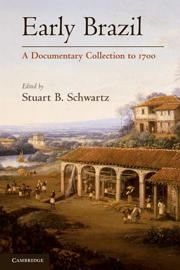Book contents
- Frontmatter
- Contents
- Preface
- A Note on Translation
- A Note on Portuguese Currency, Weights, and Measures
- Maps
- 1 The “Discovery” and First Encounters with Brazil
- 2 The Donatarial System
- 3 Royal Government
- 4 The French Interlude
- 5 Indians, Jesuits, and Colonists
- 6 The World of the Engenhos
- 7 Government and Society in Dutch Brazil
- 8 Burdens of Slavery and Race
- 9 Public and Private Power
- 10 Religion and Society
- 11 Frontiers
- Index
6 - The World of the Engenhos
Published online by Cambridge University Press: 05 June 2012
- Frontmatter
- Contents
- Preface
- A Note on Translation
- A Note on Portuguese Currency, Weights, and Measures
- Maps
- 1 The “Discovery” and First Encounters with Brazil
- 2 The Donatarial System
- 3 Royal Government
- 4 The French Interlude
- 5 Indians, Jesuits, and Colonists
- 6 The World of the Engenhos
- 7 Government and Society in Dutch Brazil
- 8 Burdens of Slavery and Race
- 9 Public and Private Power
- 10 Religion and Society
- 11 Frontiers
- Index
Summary
Sugar cane was introduced to Brazil from Madeira and São Tomé and, by the 1540s, was beginning to flourish along the coast, especially in Pernambuco and Bahia, but also in the southern captaincy of São Vicente. The sugar mills (engenhos) required land, labor, and capital. The land was seized or conquered; the labor was first obtained by enslaving the indigenous peoples, which, as we have seen, led to conflicts with the missionaries, and then by the importation of African slaves. The capital was obtained at first from Portuguese and foreign investors and subsequently was raised from other activities in the colony itself. The sugar estates were complex combinations of agriculture and industry because of the need to mill the cane immediately after harvesting it to produce sugar. By 1612, Brazil had 192 engenhos in operation and was exporting more than 10,000 tons a year to Europe. During the seventeenth century, Brazil was the greatest producer of sugar in the Atlantic world.
Excerpt from a Letter from the Administrator of Engenho, São Jorge de Erasmo
Among the first investors in the Brazilian sugar industry was the German banking firm of Erasmo Schetz, which was well established in Antwerp. Schetz funded the creation of an engenho in São Vicente and employed a Flemish agent to run the operation. That man was probably Heliodoro Eobano, whose letter of 1548 is published here. This unsigned letter reveals details about the organization and operations of an early sugar estate. Indigenous people were still the principal workers, but Africans were beginning to appear, especially as skilled workers. Sugarcane was supplied to the mill by cane farmers (called moradores here), a class of farmers that became characteristic of the Brazilian sugar industry. This letter suggests that the organization of Brazilian sugar estates had previously developed elsewhere, probably in Madeira and São Tomé, and even in the mid-sixteenth century was already in full operation in Brazil. This letter was first published by the Belgian historian Edy Stols in “Um dos primeiros documentos sobre o engenho dos Schetz em São Vicente,” Revista de História, 76 (1968), pp. 407–20.
Laus Deo. 13 May 1548, in Santos on the island of São Vicente on the coast of Brazil.
- Type
- Chapter
- Information
- Early BrazilA Documentary Collection to 1700, pp. 198 - 233Publisher: Cambridge University PressPrint publication year: 2009



